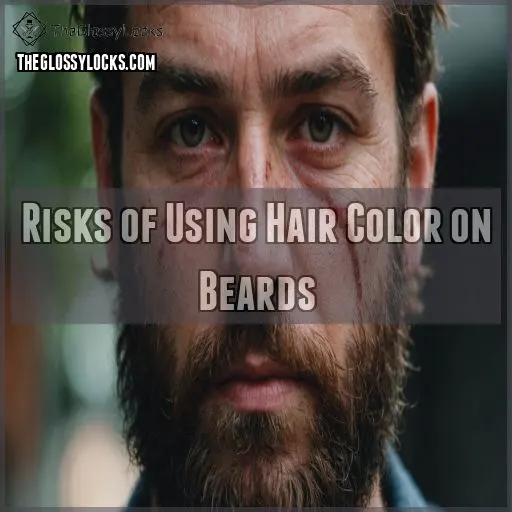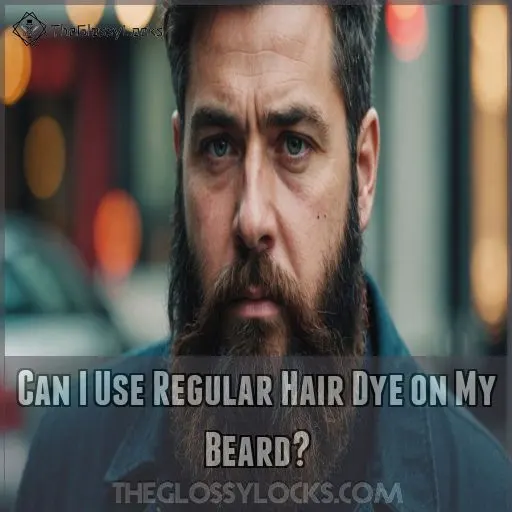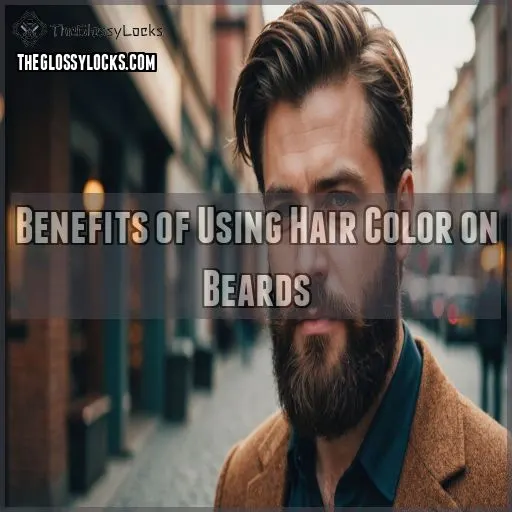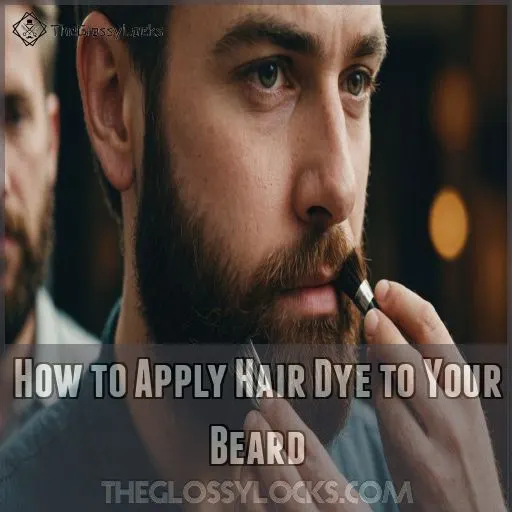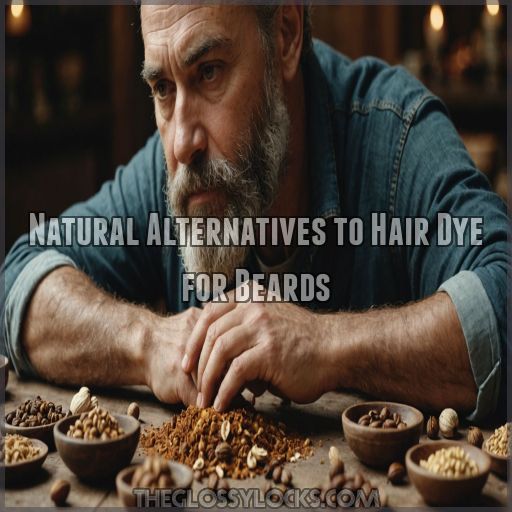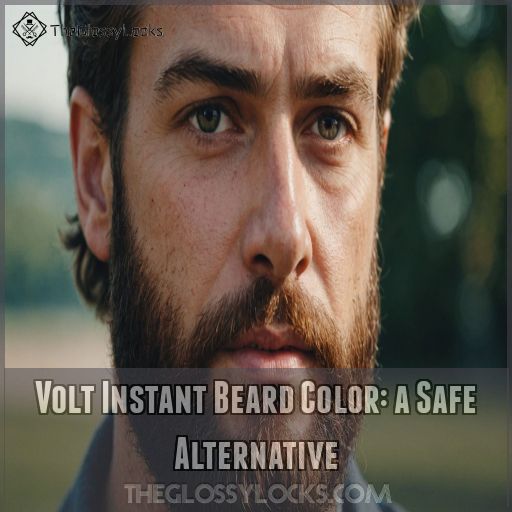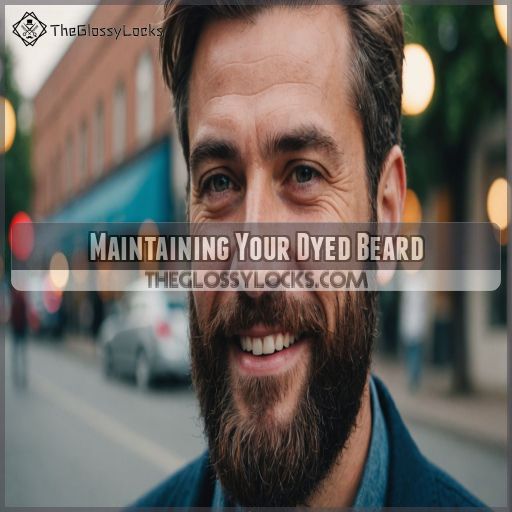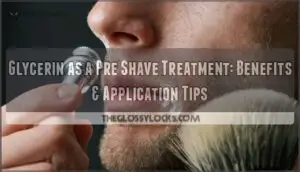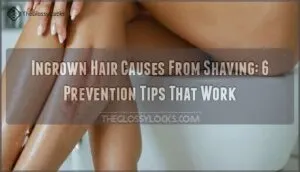This site is supported by our readers. We may earn a commission, at no cost to you, if you purchase through links.
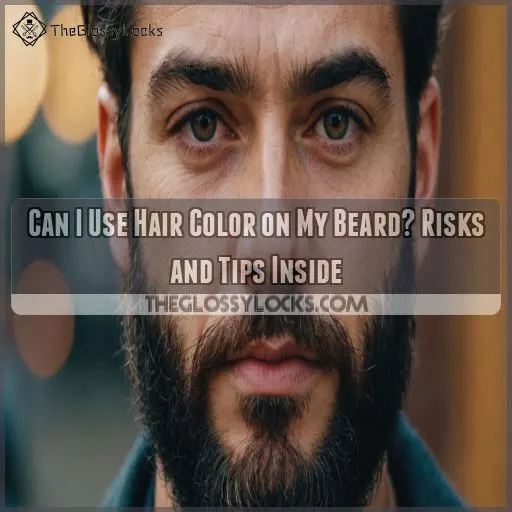 Sure, you can use hair color on your beard, but proceed with caution! Hair dye is like that friend who doesn’t always play well with others—it’s not made for facial hair and can irritate your skin or leave you looking like a cartoon character if you’re not careful.
Sure, you can use hair color on your beard, but proceed with caution! Hair dye is like that friend who doesn’t always play well with others—it’s not made for facial hair and can irritate your skin or leave you looking like a cartoon character if you’re not careful.
Your beard hair is coarser, and your face skin is more sensitive, so take it slow. Test a small area first and choose dyes meant for beards or sensitive skin.
Think of it like trimming a hedge: a little planning goes a long way. Stick around, and we’ll spill the tea on getting it just right!
Table Of Contents
- Key Takeaways
- Risks of Using Hair Color on Beards
- Can I Use Regular Hair Dye on My Beard?
- Benefits of Using Hair Color on Beards
- How to Apply Hair Dye to Your Beard
- Natural Alternatives to Hair Dye for Beards
- Volt Instant Beard Color: a Safe Alternative
- Maintaining Your Dyed Beard
- Frequently Asked Questions (FAQs)
- Can you use regular hair dye on beards?
- Is hair colour good for beard?
- How do you apply hair dye to your beard?
- Is it safe to dye a beard?
- How long does beard dye typically last?
- Can I dye my beard at home safely?
- Should I match my beard color to my hair?
- How often should I reapply beard dye?
- What are the best beard dye products on the market?
- Conclusion
Key Takeaways
- You can use hair dye on your beard, but it’s like using a jackhammer for a manicure—approach with care. Beard hair is coarser, and your skin is more sensitive, so patch test first to dodge surprises.
- Regular hair dye might leave your beard looking like an art project gone wild. For a natural look, consider beard-specific dyes or natural alternatives, like henna, to keep your color stylish and irritation-free.
- Keep your dyed beard looking sharp with some TLC. A gentle wash and conditioning routine, combined with the occasional touch-up, will ensure you avoid looking like you’ve just walked out of a tie-dye explosion.
- Boost your confidence and express your personal style with a dash of color in your beard. Whether you’re going for bold new shades or eliminating grays, make sure your chosen hue complements your overall look.
Risks of Using Hair Color on Beards
Thinking about using hair dye on your beard?
Before you leap into a colorful adventure, keep your skin safe by mastering the risks, from itchy reactions to beard-damaging chemicals, so your face fuzz doesn’t look like a mismatched science experiment.
Allergic Reactions to Hair Dye
Hair dye sensitivity can catch you off guard like a surprise party you didn’t want.
Common dye allergens like PPD might cause skin irritation or allergic reactions.
So, how do you dodge this unwanted guest? Do a patch test and stay clear of unwanted surprises.
Better safe than sorry!
Damage to Beard Hair and Skin
Ever tried using hair color on your beard? It might seem harmless, but it can lead to trouble. Imagine dealing with beard hair breakage or scalp irritation. Nobody wants that!
Be aware of:
- Hair thinning
- Dryness and itchiness
- Color fading
- Beard dye safety concerns
- Skin issues
Unnatural Color Results
Applying hair dye to your beard can lead to unnatural color results, leaving you with an unexpected shade that’s far from your desired look. Avoid this hair dye disaster by doing a patch test first and following the instructions carefully. With the right approach, you can achieve a natural, even tone.
| Unexpected Shades | Color Correction Tips | Avoiding Unevenness |
|---|---|---|
| Vibrant, unnatural hues | Consult a professional for color correction | Make sure you apply the dye evenly throughout your beard |
| Patchy, uneven coverage | Use a toning shampoo to fade unwanted color | Make sure every hair is fully saturated with dye |
Chemicals in Hair Dye
With hair dye, you’re wading into chemical waters. Many contain ammonia and PPD, causing allergies and irritation.
So, mind the ingredients like a hawk! Think of it as protecting a prized garden—nobody wants to weed out a headache, right?
Explore alternatives to keep your beard safe.
Can I Use Regular Hair Dye on My Beard?
Thinking of using hair color on your beard to cover those pesky grays or simply change things up?
Before you go all Picasso on your face, it’s important to know the differences between hair dye and beard dye, and make sure you avoid any potential skin irritation or color mishaps. Learn about beard dye.
Differences Between Hair and Beard Dye
Deciding if you can use regular hair color on your beard? It’s like using a wrench on a nail – it might work, but it’s not perfect.
Hair and beard dyes differ in:
- Product formulas
- Color consistency
- Hair texture
- Skin sensitivity
Instructions for Using Hair Dye on Beards
You’ve got the beard, now let’s get the color right. Start by doing a patch test to check for any reactions. When applying, work in small sections and use a tinting brush for precision. Rinse thoroughly and condition to keep your beard healthy and vibrant.
| Step | Instructions |
|---|---|
| 1 | Perform a patch test 24 hours prior |
| 2 | Divide beard into manageable sections |
| 3 | Apply dye with a tinting brush |
| 4 | Rinse thoroughly after recommended time |
| 5 | Condition beard to maintain health |
Precautions for Sensitive Skin
Before diving into hair color for your beard, consider a patch test to spot irritant reactions.
For a gentle approach, try:
- Opting for beard dye designed for sensitive skin
- Using temporary hair dye
- Avoiding known allergens
- Choosing gentle cleansers post-dye
Alternatives to Regular Hair Dye
Struggling with sensitive skin might make you shy away from regular hair dye. Fear not! Natural dye options exist, offering safe beard dyes for those seeking a gentle touch. Discover DIY beard dye solutions using organic ingredients for temporary coloring, like henna.
Want more? Here’s a handy comparison:
| Option | Benefits | Considerations |
|---|---|---|
| Henna | Natural, conditions hair | Limited color choices |
| Coffee dye | Subtle color, eco-friendly | Temporary effect |
| Beet juice | Vibrant, all-natural | Stains easily |
Benefits of Using Hair Color on Beards
Using hair color on your beard lets you express your personal style and cover those pesky gray hairs that make you feel like Gandalf before your time.
Experimenting with new looks can boost your confidence, so why not have a little fun with it?
Expressing Personal Style
Dyeing your beard is a fun way to express your unique style. Play with different shades to match your mood or outfit. Experiment with bold colors, subtle highlights, or even a touch of gray – the options are endless! Embrace your creativity and let your beard be your canvas.
- Express your inner artist
- Reflect your personal flair
- Stand out from the crowd
- Elevate your everyday look
- Boost your confidence
Covering Gray or White Hairs
Covering those gray hairs in your beard is like turning back the clock!
With a little beard dye, you’re not surrendering to time.
Choose from color options like black beard dye or even blonde beard dye, selecting a shade that closely aligns with your natural hair color.
Experimenting With Different Looks
Beyond just covering grays, experimenting with beard color allows you to express your unique style.
With endless beard color ideas, you can try new trends like temporary dyes for a fresh look.
Mix things up! Just remember to match your beard color styles with proper beard care.
Boosting Confidence
Just like trying on a fresh outfit, experimenting with beard color can be a fun way to boost self-esteem and embrace new style choices.
It enhances your personal image and may even change how you’re perceived, giving your confidence a boost faster than you’d expect.
How to Apply Hair Dye to Your Beard
Dyeing your beard can be a fun way to switch up your look, but it’s important to do it right.
Follow these simple steps to apply hair dye to your beard safely and achieve the perfect color. (Source)
Preparing Your Beard for Dye
Start your beard-dye journey by trimming it to your preferred length—think of it as a beard haircut.
A pre-dye cleanse removes oil and dirt, ensuring even color.
Check your skin sensitivity, and use beard grooming tools in your beard care guide for safety and health.
Choosing the Right Hair Dye
Before grabbing the hair dye, consider the color, shade, and brand that suits your personality.
- Match: Choose a shade matching your natural hair color.
- Formula: Seek gentler formulas.
- Budget: Expensive doesn’t mean better.
Applying the Hair Dye
Start by doing a patch test to avoid any beard care challenges.
For the best color selection, follow application time guidelines closely.
Apply beard dye evenly, like frosting a cake—don’t rush, especially over gray patches!
A steady hand makes sure smooth results.
Embrace your new look!
Aftercare for Dyed Beards
After dyeing your beard, use a gentle beard shampoo and conditioner to maintain the color.
Massage in a nourishing beard oil to keep your skin and hair healthy, like those listed in this article.
Trim and style your beard regularly to look sharp and well-groomed.
Natural Alternatives to Hair Dye for Beards
If you want to color your beard without risky chemicals, natural dyes like henna could be your new best friend.
They let you skip the itchy reactions and keep your beard looking great without fear of turning it an unexpected shade of "oops"!
Henna and Other Natural Dyes
Dreaming of a naturally vibrant beard?
Consider switching from chemical dyes to henna and other natural alternatives.
These options can be kinder to your skin and hair.
Creating a DIY henna mix can be fun, offering creative freedom while exploring new beard care trends and innovations.
Benefits of Natural Dyes
Natural dyes, like henna, offer fantastic benefits for your beard.
They’re safer, using ingredients from Mother Nature, and can prolong color longevity.
Whether you’re the DIY dyeing type or seeking advice from beard care specialists, these dyes align with today’s beard care market and aesthetics.
How to Use Natural Dyes on Beards
Using natural dyes like henna on your beard is a gentle, nourishing option.
Simply mix the powder with water, apply it evenly, and let it sit for an hour or two.
Rinse thoroughly for a vibrant, conditioning color boost.
Popular Natural Dye Brands
After learning how to use natural dyes, you may wonder about top brands.
Henna, indigo, and cassia stand out as key players in beard care brands.
A beard care blog, website, or social media can offer insightful brand reviews.
Embrace natural ingredients for healthy, vibrant beards!
Volt Instant Beard Color: a Safe Alternative
When you’re looking for a gentle way to color your beard without harsh chemicals, Volt Instant Beard Color might just be your new best friend.
It’s like giving your beard a stylish makeover without that post-dye damage stress!
Ingredients in Volt Instant Beard Color
Explore the ingredients in Volt Instant Beard Color, and you’ll find it fits right into beard care culture. With the use of natural ingredients like cellulose and shellac, you avoid harsh, chemical-laden options.
Cellulose’s use helps coat each hair like a comfy blanket, while shellac benefits offer sturdy, organic compounds for color staying-power.
Whether you’re a beard care influencer or simply training, Volt’s got you covered—literally!
Benefits of Using Volt Instant Beard Color
Volt Instant Beard Color offers several compelling benefits over traditional hair dyes.
For starters, it’s a natural and hypoallergenic alternative, using gentle cellulose and shellac instead of harsh chemicals.
Plus, it dries in just 30 seconds, creating a water and sweat-proof tint that’s easy to reapply anytime.
And with its ability to vary opacity and blend seamlessly, Volt helps you achieve a more natural-looking result.
How to Use Volt Instant Beard Color
For applying Volt Instant Beard Color, less really is more! Just three easy steps: Shake, Dab, and Blend. That’s it, folks!
| Step | Action | Tip |
|---|---|---|
| 1 | Shake | Give it a good shake! |
| 2 | Dab | Dab gently on your beard. |
| 3 | Blend | Blend for a natural look. |
Now you’re ready to flaunt that perfectly tinted beard without the drama or dye!
Maintaining Your Dyed Beard
Keeping your dyed beard looking sharp doesn’t need to be rocket science, but it does require some TLC.
With the right care, you can strut confidently, knowing your vibrant beard won’t resemble a tie-dye experiment gone wrong!
Washing and Conditioning Dyed Beards
You’ve got your beard looking sharp with Volt, but let’s keep it fresh.
A dyed beard care routine is key; wash with a gentle beard wash to prevent color fading.
Follow up with a nourishing beard conditioner.
Top it off with beard oil for extra softness.
Trimming and Styling Dyed Beards
Trimming your dyed beard requires extra care.
Use sharp, high-quality scissors to snip split ends and shape your look.
Styling your dyed beard is important.
Experiment with different styling products to tame flyaways and enhance the vibrancy of your color.
Embrace the process – it’s all part of the fun of rocking a dyed beard!
- Use sharp, high-quality scissors
- Snip split ends and shape your look
- Experiment with styling products
- Tame flyaways and enhance color
- Embrace the process, it’s all part of the fun
Touching Up Faded Color
Refreshed your beard? Keeping colors vibrant is like coaxing an old engine to keep purring. Factor in your color refresh frequency to plan your DIY touch-ups.
Check out this handy table:
| Action | Frequency |
|---|---|
| Inspect Color | Weekly |
| Touch-Up Gray | Every 3-4 weeks |
| Full Color Revamp | Every 6-8 weeks |
| Product Review | Every 3 months |
| Relax & Enjoy | Always |
Preventing Damage to Dyed Beards
Keeping your beard in tip-top shape after dyeing it takes a bit of dedication and pizazz. Here’s how:
- Use moisturizing products to combat dryness.
- Soft bristle brushes are your beard’s best friend.
- Avoid overdoing heat styling—it’s a risk!
- Explore hair dye alternatives.
Frequently Asked Questions (FAQs)
Can you use regular hair dye on beards?
Ever notice how suddenly beards pop with color?
You can use regular hair dye on beards, but mind those chemicals!
They can wave hello to allergies and hair damage.
Go for a patch test or natural dyes instead.
Is hair colour good for beard?
Using hair color on your beard can be a bit like a DIY project—fun but potentially tricky.
While it’s possible, hair dye may irritate facial skin.
Consider gentler beard-specific dyes for a safer, more satisfying result.
How do you apply hair dye to your beard?
Think of your beard as a canvas ready for a masterpiece!
First, apply petroleum jelly around your beard to avoid staining.
Then, mix the dye and use a brush to evenly coat your beard.
Voilà, masterpiece achieved!
Is it safe to dye a beard?
You can safely dye your beard, but it’s really important to choose a gentle, ammonia-free formula and do a patch test first.
Steer clear of harsh chemicals that could irritate your skin or damage your facial hair.
How long does beard dye typically last?
Beard dye typically lasts anywhere from two to six weeks, depending on the type and your grooming routine.
It’s like a chameleon, fading faster with frequent washing, so if you want the color to stick, handle it with care.
Can I dye my beard at home safely?
Absolutely, dyeing your beard at home is safe if you follow all instructions diligently.
Just like Picasso didn’t create masterpieces with any brush, use beard-specific products to avoid skin irritation and achieve vibrant, lasting color.
Should I match my beard color to my hair?
Deciding whether your beard should match your hair color often feels like painting two sides of a mural.
Maybe a unified look appeals, while others embrace contrast.
Trust your instincts and embrace your style!
How often should I reapply beard dye?
You’ll want to reapply your beard dye every 2-4 weeks, depending on how fast your facial hair grows.
It’s a breeze – just follow the simple instructions on the package and you’ll be looking sharp in no time!
What are the best beard dye products on the market?
Jump into a world of vibrant options!
When picking a beard dye, consider Just For Men, RefectoCil, and Volt Instant Beard Color.
They’re popular choices, catering to style, longevity, and gentleness.
Find your look and own it!
Conclusion
When pondering the question, "Can I use hair color on my beard?", the truth lies in careful consideration.
Yes, you can, but it involves balancing potential risks with desired benefits.
Be cautious—choose dyes designed for facial use, do a skin test, and follow application tips to avoid looking like a comic strip character.
Embrace the chance to refresh your style, whether you’re covering grays or expressing yourself.

